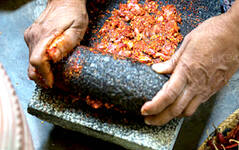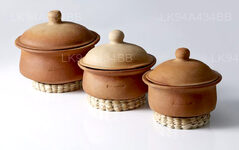
Kitchen Equipment
Homes & Gardens is a British monthly interior design and garden design magazine published by Future plc. The magazine is based in London and has been in circulation since 1919. As the UK’s first-ever home interest magazine, Homes & Gardens has been shaping British style for over 100 years.
Traditional Kitchen Utensils
GRINDING STONE
One of the oldest tools used in Sri Lankan cooking, the ‘miris gala’ is a two-stone grinder used to crush ingredients. It consists of one large, flat stone (used as the base) and another cylindrical stone (used like a rolling pin). Even though you can use a modern blender as an alternative, it won’t give you a fine paste and the same taste.
MOTAR AND PESTLE
Known as the wangediya and the mol gaha in Sinhalese, the mortar and pestle is used to crush ingredients like ginger, garlic and cumin seeds for curries. The ingredients are placed in the chalice-shaped mortar, and the pestle is used to crush the spices.
HANDMADE SPOONS
Traditionally used in Sri Lankan cooking, these are made by hand from a coconut shell and come in many different sizes. A variety of modern spoons are available at markets, but they can’t beat the coconut shell spoon’s heat-absorbing ability, depth, and simplicity of use.
COCONUT SCRAPER
Coconut milk and grated coconut are two much used ingredients in our island’s cuisine. For the grating of the coconut, a coconut scraper or hiramanaya was the kitchen equipment of choice in most Sri Lankan households.
CLAY POTS
These are also known as ‘walang’ and is used to cook and serve curries. It is believed that clay enhances the flavor and aroma of the food, so the best curries come from clay pots. Modern materials such as metal do not give the same result. Additionally, research shows that clay has a high food-preserving ability as it protects food from bacteria. Clay pots can be placed directly on a flame when cooking and are often taken straight to the table for serving
STRING HOPPER PRESS
Also known as an ’indiyappam wangediya’, a string hopper press is used to make rice noodles called string hoppers. Flour dough is pressed through the metal tube, which creates fine strings. It is the only way to make string hoppers.
PITTU BAMBOO
This is the traditional method used to make pittu – the mixture is placed inside the bamboo and then steamed. Even though similar aluminum tools are found in the market, bamboo enables the food to be cooked using steam, which keeps the natural flavor.
CLAY WATER PITCHER
The guruletthuwa is the earthenware water jug or vessel that was traditionally used in Sri Lankan homes. It, too, is fashioned out of clay that was made hard and brittle by sun drying or fire, but was still porous enough to allow the night air to cool the water which was stored in it overnight. Its companion is the water pot or kala gediya which is used to fetch water from a well or river. The guruletthuwa can still be found in certain homes, sometimes with earthenware cups or tumblers to match.
-
Lakpura Aluminium Hopper Pan with Lid and Spatula
Regular price From Rs 1,100.00 LKRRegular priceUnit price / perRs 1,300.00 LKRSale price From Rs 1,100.00 LKRSale -
Lakpura Oil Cake Mold (Konda Kawum Achchu)
Regular price From Rs 200.00 LKRRegular priceUnit price / perRs 300.00 LKRSale price From Rs 200.00 LKRSale -
Lakpura Nonstick Kokis Mould
Regular price From Rs 1,500.00 LKRRegular priceUnit price / perRs 1,700.00 LKRSale price From Rs 1,500.00 LKRSale -
Odiris Stainless Steel Coconut Scraper
Regular price From Rs 4,200.00 LKRRegular priceUnit price / perRs 4,900.00 LKRSale price From Rs 4,200.00 LKRSale














